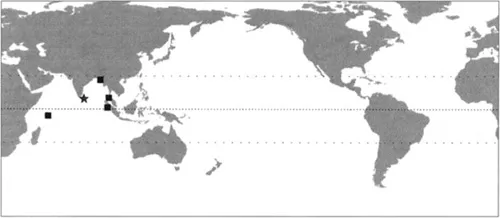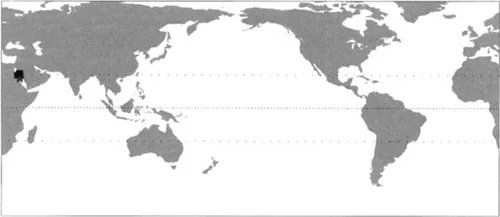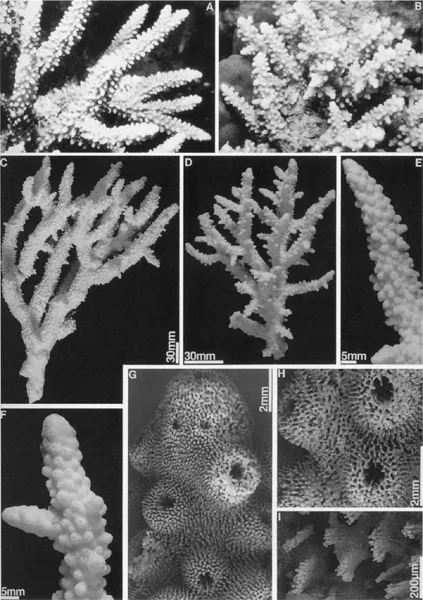
eBook - ePub
Staghorn Corals of the World
A Revision of the Genus Acropora
Carden Wallace
This is a test
- 438 pages
- English
- ePUB (mobile friendly)
- Available on iOS & Android
eBook - ePub
Staghorn Corals of the World
A Revision of the Genus Acropora
Carden Wallace
Book details
Book preview
Table of contents
Citations
About This Book
Staghorn corals (genus Acropora ) are the most obvious and important corals on coral reefs throughout the world, providing much of the beauty and variety seen on the reefs.
This invaluable reference tool is the first major review of Acropora in over 100 years. It assesses all the known species worldwide, describing each in detail and illustrating the range of variability of form with habitat and geographic location. The classification, evolution and worldwide distribution of all species are reviewed and illustrated with colour plates, full page black and white plates and distribution maps. Details of the general biology of staghorn corals are discussed and illustrated.
Frequently asked questions
How do I cancel my subscription?
Can/how do I download books?
At the moment all of our mobile-responsive ePub books are available to download via the app. Most of our PDFs are also available to download and we're working on making the final remaining ones downloadable now. Learn more here.
What is the difference between the pricing plans?
Both plans give you full access to the library and all of Perlego’s features. The only differences are the price and subscription period: With the annual plan you’ll save around 30% compared to 12 months on the monthly plan.
What is Perlego?
We are an online textbook subscription service, where you can get access to an entire online library for less than the price of a single book per month. With over 1 million books across 1000+ topics, we’ve got you covered! Learn more here.
Do you support text-to-speech?
Look out for the read-aloud symbol on your next book to see if you can listen to it. The read-aloud tool reads text aloud for you, highlighting the text as it is being read. You can pause it, speed it up and slow it down. Learn more here.
Is Staghorn Corals of the World an online PDF/ePUB?
Yes, you can access Staghorn Corals of the World by Carden Wallace in PDF and/or ePUB format, as well as other popular books in Biological Sciences & Marine Biology. We have over one million books available in our catalogue for you to explore.
Information
SYSTEMATIC ARRANGEMENT OF SPECIES
PHYLUM Cnidaria
CLASS Anthozoa
SUBCLASS Zoantharia
ORDER Scleractinia
SUBORDER Astrocoeniina Vaughan & Wells, 1943
FAMILY Acroporidae Verrill, 1902
GENUS Acropora Oken, 1815
Acropora Oken, 1815 p.66
TYPE SPECIES Millepora muricata Linnaeus, 1758
Genus name and type species officially validated in 1963 (Boschma, 1961; China, 1963). “Acroporidae which are ramose, rarely massive or encrusting, branching with an axial or leading corallite (or corallites) larger than the more numerous radial corallites budded from it (or them); united by light, reticulate, spinose or pseudo-costate or costate coenosteum. Columella and dissepiments absent”. (Description taken from Wallace, 1978 p.277, modified from Wells, 1956 p. F374.)
SUBGENUS Acropora Oken, 1815 p.66
Single axial corallite forms axis of branch, opening at tip. Radial corallites and coenosteum various.
THE Acropora rudis GROUP
Radial corallites rounded tubular; evenly sized; coenosteum throughout includes elaborated spinules; colonies with simple, irregular branching.
The axial corallite makes the major contribution to branch diameter in these thick-branched, simple, sturdy corals. The sturdiness is also reflected in the large number of synapticular rings that make up the walls of the corallites, so that the radial corallite walls are thick and sometimes swollen, with calices relatively small. All species occur subtidally.
With the exception of the widespread Acropora austera, species in this group are restricted to the Indian Ocean or Red Sea.
Acropora (Acropora) rudis (Rehberg, 1892)
(Map 1, Plate 1)
Madrepora rudis Rehberg, 1892 p.41 p1.4 fig.9
Material examined
MNB: 2693 Ceylon (Sri Lanka) Madrepora rudis holotype
MNB: 2693 Ceylon (Sri Lanka) Madrepora rudis holotype
MTQ: Seychelles: G51792; Sri Lanka: G55223–4; Bangladesh: G50567; Thailand: G37293, G37302; Indonesia: G47165–6 W. Sumatra
Skeletal characteristics
Corallum. Irregular arborescent with sturdy, erect, tapering branches 12–40 mm diameter and up to 160 mm long; sometimes incipient axial corallites are common, contributing to the irregular branching pattern; growth indeterminate.
Corallites. Axial corallites outer diameter 2.6–4.1 mm, inner diameter 0.6–1.2 mm; primary septa present up to 3/4R, secondary septa to 1/2R; radial corallites evenly sized, touching on branches, rounded tubular or rounded tubular-conical, with round calices, primary septa present up to 1/2R, secondary septa some to all present up to 1/3R.
Coenosteum. A dense arrangement of elaborated spinules throughout.
Field characteristics
The very large corallite size and rounded appearance of radial corallites of this species, as well as the sturdy branches, are distinctive. Colonies are irregular, up to about a metre in diameter, with branches directed upwards or horizontally: in some habitats branches extend horizontally and then turn downwards; known colours a velvety dark green or brown; occurs in rocky fringing reefs, shallow reef edge and submerged reef top habitats.
Other systematic information and remarks
This species is apparently restricted to the Indian Ocean, specimens having been found in Sri Lanka (type locality), Bangladesh, W. Thailand (where it is common), Seychelles and western Sumatra. The fact that these localities are not often sampled may explain the lack of literature records.
Fossil record
None.
Further literature
Taxonomy and distribution: Wallace & Wolstenholme, 1998.

MAP 1 Distribution of Acropora rudis worldwide, taken from literature records (triangles), type localities of senior and junior synonyms (stars) and specimen-based records in Worldwide Acropora Database at MTQ (squares).

PLATE 1 Acropora rudis (A,B) in W. Thailand; (C,E,H,I) G37293 W. Thailand (D,F,G) G37302 W. Thailand; (A,B) live colony (C,D) portion of colony (E,F) portion of branch (G) electron micrograph showing axial and radial corallites (H) electron micrograph showing radial corallites (I) electron micrograph showing coenosteum between radial corallites.
Acropora (Acropora) variolosa (Klunzinger, 1879)
(Map 2, Plate 2)
Madrepora variolosa Klunzinger, 1879 p.8 p1.1 fig.6 p1.4 fig.6 p1.9 fig.3
Madrepora obtusata Klunzinger, 1879 p.7 p1.1 fig.5 p1.8 fig.18a,b p1.9 fig.2
Madrepora klunzingeri Quelch, 1886 p.158; = Madrepora pustulosa Klunzinger, 1879 (non Edwards & Haime) p.8 p1.1 fig.1 p1.4 fig.15 p1.9 fig.4
Material examined
MNB: 2111 Red Sea Madrepora variolosa holotype; 2112 Red Sea Madrepora klunzingeri holotype; 2113 Red Sea Madrepora obtusata holotype
MTQ: Red Sea: G53550 Sudan; G54681, G54683, G54859, G54862, G55184–5, G55235–6 Saudi Arahia
Skeletal characteristics
Corallum. Arborescent, with sturdy, tapering branches 8–30 mm diameter and up to 115 mm long; growth indeterminate, sometimes thickets being formed.
Corallites. Axial corallites outer diameter 2.2–3.8 mm, inner diameter 0.7–l.2 mm; primary septa present up to 2/3R, secondary septa to 1/2R; radial corallites evenly sized, projecting directly outward from branches, not touching, tubular-conical, with round calices, primary septa present up to 2/3R, secondary septa absent or up to all present, up to 1/3R.
Coenosteum. A dense arrangement of elaborated spinules throughout.
Field characteristics
Colonies range from caespitose to irregular arborescent thickets, with distinctive thick branches and obvious large tubular-conical radial corallites; known colour blue or pale brown; occurs in sandy lagoonal situations.
Other systematic information and remarks
Problems with the delimitation of this species stem from confusion with Acropora austera as well as the questionable affinities of A. hemprichii. Authors have variously combined two of the three species. Acropora variolosa appears to be confined to the Red Sea and to be distinguished from other species by its long and distinctly conical radial corallites with their round openings, the most similar species being A. rudis, which is apparently restricted to more easterly Indian Ocean locations. Madrepora klunzingeri Quelch, 1886 was a replacement name for M. pustulosa Klunzinger, 1879, a junior homonym of M. pustulosa Edwards & Haime, 1860.
Fossil record
None.
Further literature
Taxonomy and distribution: Sheppard & Sheppard, 1991 (as Acropora hemprichii). Biology: Antonius & Riegl, 1998 (as A. hemprichi).

MAP 2 Distribution of Acropora variolosa worldwide

PLATE 2 Acropora variolosa (A,B) in Saudi Arabia, Red Sea (M. Pichon); (C,G,I) G54683 Red Sea (D) G54859 Red Sea (E) G54862 Red Sea (F,H) G54681 Red Sea; (A,B) live colony (C,D)...
Table of contents
- Cover
- Title
- Copyright
- Dedication
- Foreword
- Abstract
- Acknowledgements
- Contents
- Introduction
- Review of Literature
- Summary of Type Material
- Fossil Record
- Anatomy, Physiology and Biology
- Genetics and Molecular Biology
- Skeletal Morphology
- Methods Used for Revision and Analyses
- Revision of the Biogeography of Acropora
- Revision of the Phylogeny and Classification of Acropora
- Synthesis of Biogeographic, Fossil and Phylogenetic Data
- Systematic Arrangement of Species
- Subgenus Isopora Studer, 1878
- Insertae Sedis Acropora Squamata Latypov, 1992
- References
- Appendix
- Glossary
- Abbreviations
- Index
- Species Index